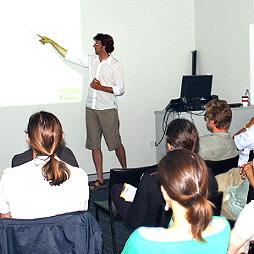Posted 9 December 2011

The broad scope of disciplines represented at the meeting showcased a variety of approaches to understanding preferential flow.
Preferential flow was the focus of a specialist joint meeting of the Connected Waters Initiative with colleagues from the National Centre for Groundwater Research and Training (NCGRT) and the Australian Nuclear Science and Technology Organisation (ANSTO).
A large variety of examples from the micro-scale to the field and catchment scale were showcased in order to define and explore preferential flow, reflecting the broad disciplinary scope of the participants.
Preferential flow occurs when fluid is transported fairly haphazardly, rather than moving as a continuous front as predicted by basic equations for flow in any porous media.
This phenomenon is well known in soil science, however it remains a very difficult process to constrain in groundwater studies.
Classic groundwater modelling involves aquifers in fractured rocks where the flow of water is completely dictated by the fracture network connectivity and orientation.
However, the potential and influence of preferential flow in porous media with contrasts in porosity is less well-known. Such contrasts in porosity - usually referred to as heterogeneity - are caused by the large variabilities in the geological architecture of the substrate.
While the classic hydrogeological view is that aquifers within sedimentary rocks will generally occur within the coarser grain size material, heterogeneity makes it possible for a dense fracture network in finer grained units to transfer and store much more significant volumes of water than its nearby coarser grained counterpart. Heterogeneities are also recognised at much smaller scales, which are often investigated in laboratory experiments, and all have shown the strong influence of very small changes in porosity on the overall flow structure of water and any tracers or contaminants within it.
It was generally agreed that most of the time the issue of preferential flow is avoided, since most models and flow assumptions use the classic assumptions of ideal porous media.
However, this may be resulting in increasingly cornering interpretations within this classic framework at the expense of a reality in which preferential flow may be the most critical processes governing the subsurface transport of water.
Such problems are not completely trivial, since our conceptual understanding drives the treatment of contaminated groundwater, or the estimation of groundwater recharge rates.
An outcome of the meeting was to consolidate and summarise the current state of knowledge on this broad topic, and over the coming months to work to produce a review of the problems, specific examples, and finally some directions for future study. Hopefully such a review can stimulate and encourage a greater incorporation of preferential flow within our conceptual understanding of all groundwater systems.
Links

Professor Andy Baker features in American Water Resources Association ‘Water Resources Impact’, September 2020 edition.

The Connected Waters Initiative (CWI) is pleased to welcome Taylor Coyne to its network as a postgraduate researcher. If you’re engaged in research at a postgraduate level, and you’re interested in joining the CWI network, get in touch! The CWI network includes multidisciplinary researchers across the Schools of Engineering, Sciences, Humanities and Languages and Law.

The Grand Challenge on Rapid Urbanisation will establish Think Deep Australia, led by Dr Marilu Melo Zurita, to explore how we can use our urban underground spaces for community benefit.

On the 21 August 2020, CWI researchers made a submission to the National Water Reform Inquiry, identifying priority areas and making a number of recommendations as to how to achieve a sustainable groundwater future for Australia.

Results published from a research project between the Land Development Department (LDD) Thailand and UNSW has demonstrated how 2-dimensional mapping can be used to understand soil salinity adjacent to a earthen canal in north east Thailand (Khongnawang et al. 2020).